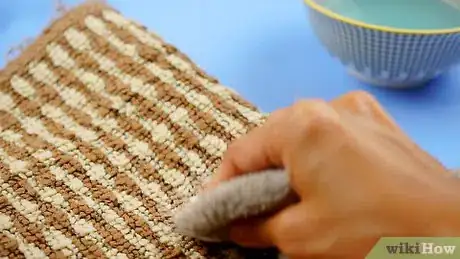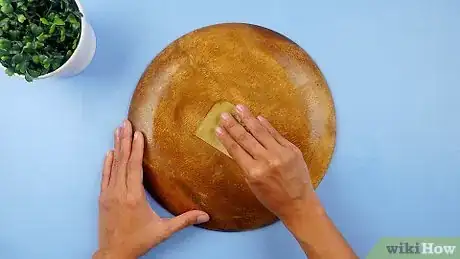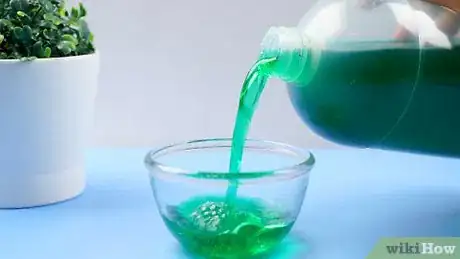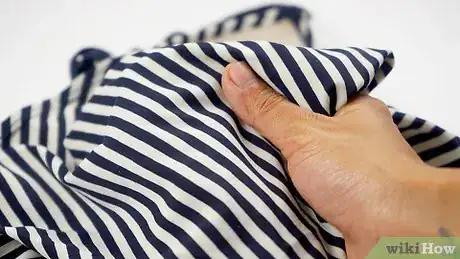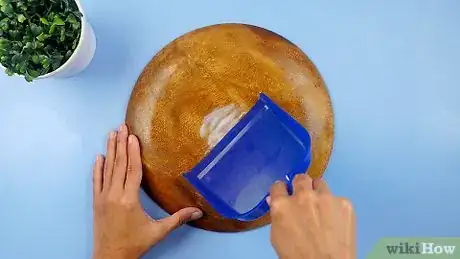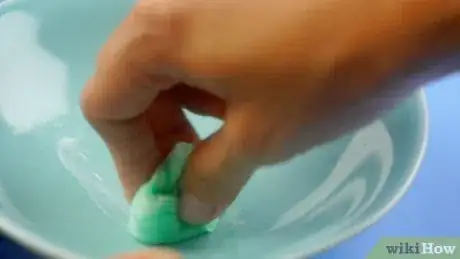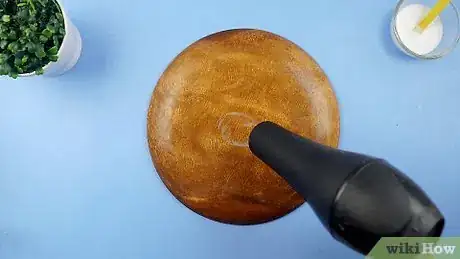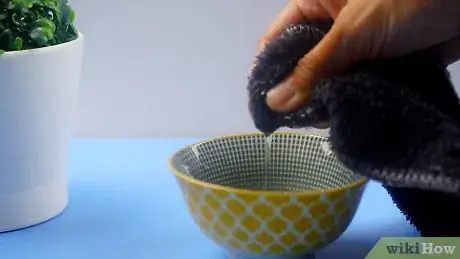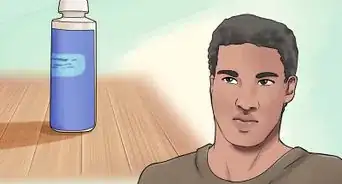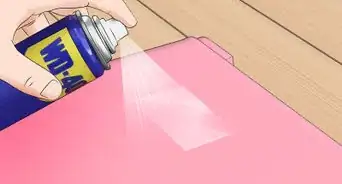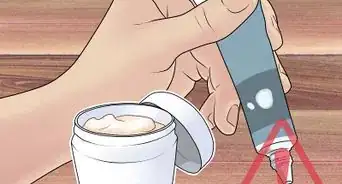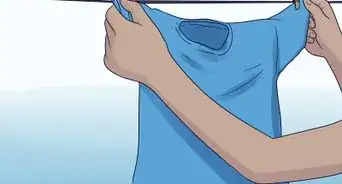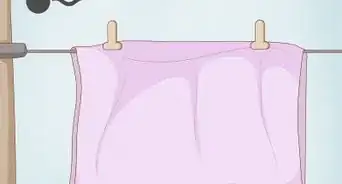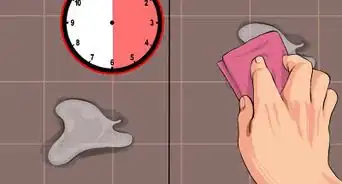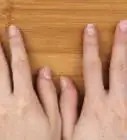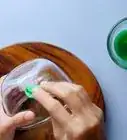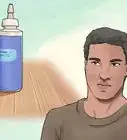This article was co-authored by Guy Peters. Guy Peters is the Owner of MOP STARS Cleaning Service, a complete house cleaning service for residential and commercial clients, based in Denver, Colorado. Founded in 2014, MOP STARS provides regular, move in/out, deep, and commercial cleaning services. Guy has a BA in Finance from the California State University - Sacramento and an MBA from Cornell University.
There are 12 references cited in this article, which can be found at the bottom of the page.
This article has been viewed 19,230 times.
Glue can be a real pain if it gets on something it's not supposed to! Don't worry, though, most glues will come up with a bit of work. Try out different methods depending on the type of glue and the surface; what works on one may not work on another. No matter what solvent you use, make sure to test it out first in an inconspicuous place to make sure it won't damage the material.
Steps
Removing Superglue
-
1Dab soapy water if you spilled superglue on carpet. Dampen a rag with dish soap dissolved in warm water. Pat the carpet with the rag to work on the glue. Try not to get it too wet. Once most of the glue is gone, pat it dry with a clean cloth.[1]
- Repeat the process as needed to remove the glue.
-
2Apply acetone to clothing items with superglue.[2] Get a bit of acetone on a clean rag. Place a towel behind the fabric and then pat at it with the acetone. Keep dabbing at until the glue is gone. Then, once you've completely removed the superglue, wash the piece of clothing as usual to remove the acetone.[3]
- Nail polish removers traditionally have acetone, though some removers are acetone-free. Check yours before attempting to use it.
- You can also try applying laundry detergent to the stain and letting it sit a few minutes before washing.[4]
Advertisement -
3Mix baking soda with coconut oil to get superglue off of skin. Stir together a dime-sized amount of coconut oil with an equal amount of baking soda. Once it's thoroughly mixed, rub the mixture into the skin where the superglue is and let it sit for 15 minutes. Then, after 15 minutes, wash your skin with soap and water to remove.[5]
- You can also try other vegetable oils by themselves or even petroleum jelly or antibiotic ointment. The oil may be enough to dissolve the glue.
- Rubbing alcohol may also work.[6]
-
4Scrub durable materials with fine sandpaper. If other solutions haven't worked, try rubbing fine grit sandpaper gently over the area. Just be sure not to dig into the material below. Use a light touch and fine grit sandpaper if possible.[7]
- You could also try to scrape it off with a razor blade, though this has an even higher chance of damaging the surface if you aren't careful.
-
5Rub a melamine sponge over less durable materials. Lightly wet a melamine sponge and scrub the area in a circular motion. Keep scrubbing until the glue is all gone.[8]
- Melamine sponges help remove stains and things like glue with light abrasion, working somewhat like fine sandpaper. However, they usually leave the surface unharmed.
Taking off Sticker Residue
-
1
-
2Take sticker residue off of synthetic fibers like spandex with the freezer and dish soap. Start by putting the clothing item in the freezer for at least an hour. Then, once the glue has hardened, pull the item out and peel off as much glue as you can. Use warm water and dish soap to remove the rest. When you're finished, let the clothes sit in warm water for 20 minutes, then wash as usual.[11]
-
3Use oil to remove adhesive from plastic. Dip a cloth in any type of cooking oil, such as vegetable oil or olive oil. Pat at the adhesive with the oil and then let it sit in for a few minutes. Once it's soaked through, use a clean rag to wipe off the residue. Continue as needed, then clean the plastic with soap and water.[12]
- You can also use a moisturizer or mineral oil.
-
4Place glass bottles in warm, soapy water to remove labels and stickers. Fill the sink or a large bowl with warm water and a few drops of dishwashing soap. Stir it around to mix it together. Set the bottle in the mixture, making sure the label or adhesive is underwater. Leave the glass for a few hours, then remove and clean as usual.[13]
- If you can leave it overnight, that's even better.
Removing School Glue or Other Household Glues
-
1Scrape glass, wood, and other surfaces with a plastic putty knife.[14] If you have big globs of glue, try to get as much as you can up before you try solvents. Scrape at the area with a putty knife until you've gotten up as much as you can. You can also try peeling the pieces off with your fingers if they're large enough.[15]
- Picking at the glue with your fingers works especially well if the glue residue is on carpet or fabric.
-
2Use water and detergent to get school glue out of carpet. Mix a few drops of laundry detergent into a cup of water. Then, dip a clean rag into it and lightly dab at the carpet until the glue comes up. Use clean water to remove the detergent.[16]
- Try not to get it too wet. Dab at it with a clean towel when you're done.
- For clothing, just throw it in the wash with normal detergent.
-
3Apply acetone to stubborn stains on most surfaces. If the glue is harder than school glue and won't come up, dip a rag into acetone. Dab the glue with the rag, then continue applying acetone until the stain comes up.[17]
- Be cautious when applying acetone to wood surfaces, since it may take the finish off. Test an inconspicuous area first. Also, don't use it on plastic, as it may dissolve the material.[18]
-
4Use a blow dryer to release glue from wood.[19] This works best for globs of glue. Place the dryer on its lowest setting and hold it over the glue for about 15 seconds. The glue globs should be soft enough to peel off the wood with your fingers or a putty scraper. Remove what you can, then repeat as needed.[20]
- This also works for stickers.
Lifting Epoxies
-
1Dab at epoxy with acetone before it sets. Dip a clean rag in acetone and run it over the wet glue. Try to work at the glue as fast as you can, as you don't want it to set before you get it up.[21]
- Two-part epoxies tend to set very hard, so it's best to get it up before it dries if you can.
-
2Try methylated spirits on epoxy if acetone doesn't work. Dampen a clean cloth with the methylated spirits. Then, rub at the epoxy in a circular motion, working quickly to get it up before it sets.[22]
-
3Rub the area with sandpaper or a melamine sponge if the glue is already set. Try a melamine sponge first. Dip it in water and go over the area in a circular motion. If that doesn't work, move on to fine grit sandpaper. Keep working at the area until you get the glue up.[23]
- You may need to start with heavier sandpaper if you have a big spill.
Expert Q&A
-
QuestionHow do you remove dried glue from glass?
 Guy PetersGuy Peters is the Owner of MOP STARS Cleaning Service, a complete house cleaning service for residential and commercial clients, based in Denver, Colorado. Founded in 2014, MOP STARS provides regular, move in/out, deep, and commercial cleaning services. Guy has a BA in Finance from the California State University - Sacramento and an MBA from Cornell University.
Guy PetersGuy Peters is the Owner of MOP STARS Cleaning Service, a complete house cleaning service for residential and commercial clients, based in Denver, Colorado. Founded in 2014, MOP STARS provides regular, move in/out, deep, and commercial cleaning services. Guy has a BA in Finance from the California State University - Sacramento and an MBA from Cornell University.
House Cleaning Professional Try scraping it off with a plastic card. In case anything goes wrong, be sure to use a grocery store membership card instead of a credit card.
Try scraping it off with a plastic card. In case anything goes wrong, be sure to use a grocery store membership card instead of a credit card. -
QuestionHow do you get sticker residue off without alcohol?
 Guy PetersGuy Peters is the Owner of MOP STARS Cleaning Service, a complete house cleaning service for residential and commercial clients, based in Denver, Colorado. Founded in 2014, MOP STARS provides regular, move in/out, deep, and commercial cleaning services. Guy has a BA in Finance from the California State University - Sacramento and an MBA from Cornell University.
Guy PetersGuy Peters is the Owner of MOP STARS Cleaning Service, a complete house cleaning service for residential and commercial clients, based in Denver, Colorado. Founded in 2014, MOP STARS provides regular, move in/out, deep, and commercial cleaning services. Guy has a BA in Finance from the California State University - Sacramento and an MBA from Cornell University.
House Cleaning Professional A hair dryer can work! Heat helps loosen up adhesive residue, and is a good option for more sensitive items.
A hair dryer can work! Heat helps loosen up adhesive residue, and is a good option for more sensitive items. -
QuestionCan I use acetone to remove sticker residue on plastic?
 Guy PetersGuy Peters is the Owner of MOP STARS Cleaning Service, a complete house cleaning service for residential and commercial clients, based in Denver, Colorado. Founded in 2014, MOP STARS provides regular, move in/out, deep, and commercial cleaning services. Guy has a BA in Finance from the California State University - Sacramento and an MBA from Cornell University.
Guy PetersGuy Peters is the Owner of MOP STARS Cleaning Service, a complete house cleaning service for residential and commercial clients, based in Denver, Colorado. Founded in 2014, MOP STARS provides regular, move in/out, deep, and commercial cleaning services. Guy has a BA in Finance from the California State University - Sacramento and an MBA from Cornell University.
House Cleaning Professional That's not a great idea. While acetone does remove sticker residue, it may also dissolve certain types of plastic.
That's not a great idea. While acetone does remove sticker residue, it may also dissolve certain types of plastic.
References
- ↑ https://www.goodhousekeeping.com/uk/house-and-home/household-advice/a656989/remove-glue-stains/
- ↑ Guy Peters. House Cleaning Professional. Expert Interview. 27 September 2021.
- ↑ https://www.goodhousekeeping.com/uk/house-and-home/household-advice/a656989/remove-glue-stains/
- ↑ https://www.familyhandyman.com/diy-advice/25-ways-you-havent-tried-to-remove-super-glue/
- ↑ https://www.familyhandyman.com/diy-advice/25-ways-you-havent-tried-to-remove-super-glue/
- ↑ Guy Peters. House Cleaning Professional. Expert Interview. 27 September 2021.
- ↑ https://www.familyhandyman.com/diy-advice/25-ways-you-havent-tried-to-remove-super-glue/
- ↑ https://www.familyhandyman.com/diy-advice/25-ways-you-havent-tried-to-remove-super-glue/
- ↑ Guy Peters. House Cleaning Professional. Expert Interview. 27 September 2021.
- ↑ https://www.realsimple.com/beauty-fashion/clothing-care/sticker-residue
- ↑ https://www.realsimple.com/beauty-fashion/clothing-care/sticker-residue
- ↑ https://www.cleanipedia.com/gb/floor-and-surface-cleaning/how-to-remove-glue.html
- ↑ https://www.cleanipedia.com/gb/floor-and-surface-cleaning/how-to-remove-glue.html
- ↑ Guy Peters. House Cleaning Professional. Expert Interview. 27 September 2021.
- ↑ https://www.bobvila.com/articles/how-to-remove-glue/
- ↑ https://www.goodhousekeeping.com/uk/house-and-home/household-advice/a656989/remove-glue-stains/
- ↑ https://www.goodhousekeeping.com/uk/house-and-home/household-advice/a656989/remove-glue-stains/
- ↑ Guy Peters. House Cleaning Professional. Expert Interview. 27 September 2021.
- ↑ Guy Peters. House Cleaning Professional. Expert Interview. 27 September 2021.
- ↑ https://www.bobvila.com/articles/how-to-remove-glue/
- ↑ https://www.goodhousekeeping.com/uk/house-and-home/household-advice/a656989/remove-glue-stains/
- ↑ https://www.goodhousekeeping.com/uk/house-and-home/household-advice/a656989/remove-glue-stains/
- ↑ https://www.familyhandyman.com/diy-advice/25-ways-you-havent-tried-to-remove-super-glue/
About This Article
The best way to remove glue stains depends on the kind of glue and what type of surface you’re cleaning. For example, if you’ve spilled super glue on a carpet, gently pat the area with soapy water on a cloth or rag, then pat the area dry with a clean cloth when you’re done. To get superglue out of clothing, dab it with an acetone-based nail polish remover. If the glue is on your skin, you can loosen it by rubbing it with coconut oil and baking soda. Let the mixture sit for 15 minutes, then wipe it away. For harder surfaces, like plastic or wood, you may be able to scrub the glue away with sandpaper or a melamine sponge. To learn how to clean off sticker residue, keep reading!
